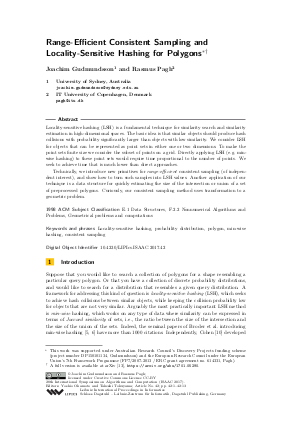Range-Efficient Consistent Sampling and Locality-Sensitive Hashing for Polygons
Authors Joachim Gudmundsson, Rasmus Pagh
-
Part of:
Volume:
28th International Symposium on Algorithms and Computation (ISAAC 2017)
Part of: Series: Leibniz International Proceedings in Informatics (LIPIcs)
Part of: Conference: International Symposium on Algorithms and Computation (ISAAC) - License:
 Creative Commons Attribution 3.0 Unported license
Creative Commons Attribution 3.0 Unported license
- Publication Date: 2017-12-07
File

PDF
LIPIcs.ISAAC.2017.42.pdf
- Filesize: 0.52 MB
- 13 pages
Document Identifiers
Subject Classification
Keywords
- Locality-sensitive hashing
- probability distribution
- polygon
- min-wise hashing
- consistent sampling
Metrics
- Access Statistics
-
Total Accesses (updated on a weekly basis)
0Document
0Metadata
Abstract
Locality-sensitive hashing (LSH) is a fundamental technique for similarity search and similarity estimation in high-dimensional spaces. The basic idea is that similar objects should produce hash collisions with probability significantly larger than objects with low similarity. We consider LSH for objects that can be represented as point sets in either one or two dimensions. To make the point sets finite size we consider the subset of points on a grid. Directly applying LSH (e.g. min-wise hashing) to these point sets would require time proportional to the number of points. We seek to achieve time that is much lower than direct approaches. Technically, we introduce new primitives for range-efficient consistent sampling (of independent interest), and show how to turn such samples into LSH values. Another application of our technique is a data structure for quickly estimating the size of the intersection or union of a set of preprocessed polygons. Curiously, our consistent sampling method uses transformation to a geometric problem.
Cite As Get BibTex
Joachim Gudmundsson and Rasmus Pagh. Range-Efficient Consistent Sampling and Locality-Sensitive Hashing for Polygons. In 28th International Symposium on Algorithms and Computation (ISAAC 2017). Leibniz International Proceedings in Informatics (LIPIcs), Volume 92, pp. 42:1-42:13, Schloss Dagstuhl – Leibniz-Zentrum für Informatik (2017)
https://doi.org/10.4230/LIPIcs.ISAAC.2017.42
BibTex
@InProceedings{gudmundsson_et_al:LIPIcs.ISAAC.2017.42,
author = {Gudmundsson, Joachim and Pagh, Rasmus},
title = {{Range-Efficient Consistent Sampling and Locality-Sensitive Hashing for Polygons}},
booktitle = {28th International Symposium on Algorithms and Computation (ISAAC 2017)},
pages = {42:1--42:13},
series = {Leibniz International Proceedings in Informatics (LIPIcs)},
ISBN = {978-3-95977-054-5},
ISSN = {1868-8969},
year = {2017},
volume = {92},
editor = {Okamoto, Yoshio and Tokuyama, Takeshi},
publisher = {Schloss Dagstuhl -- Leibniz-Zentrum f{\"u}r Informatik},
address = {Dagstuhl, Germany},
URL = {https://drops.dagstuhl.de/entities/document/10.4230/LIPIcs.ISAAC.2017.42},
URN = {urn:nbn:de:0030-drops-82316},
doi = {10.4230/LIPIcs.ISAAC.2017.42},
annote = {Keywords: Locality-sensitive hashing, probability distribution, polygon, min-wise hashing, consistent sampling}
}
Author Details
References
-
S. Arya and D. M. Mount. Approximate range searching. Computational Geometry - Theory and Applications, 17:135-152, 2000.

-
Y. Bachrach and E. Porat. Sketching for big data recommender systems using fast pseudo-random fingerprints. In Proceedings of 40th International Colloquium on Automata, Languages, and Programming (ICALP), pages 459-471. Springer, 2013.

-
J. L. Bentley. Algorithms for Klee’s rectangle problems. Unpublished note, Computer Science Department, Carnegie Mellon University, 1977.

-
K. Bringmann and T. Friedrich. Approximating the volume of unions and intersections of high-dimensional geometric objects. Computational Geometry - Theory and Applications, 43(6-7):601-610, 2010.

-
A. Z. Broder. On the resemblance and containment of documents. In Proceedings of International Conference on Compression and Complexity of Sequences (SEQUENCES), pages 21-29. IEEE, 1997.

-
A. Z. Broder, S. C. Glassman, M. S. Manasse, and G. Zweig. Syntactic clustering of the web. Computer Networks and ISDN Systems, 29(8):1157-1166, 1997.

-
J. L. Carter and M. N. Wegman. Universal classes of hash functions. In Proceedings of 9th ACM Symposium on Theory of Computing (STOC), pages 106-112. ACM, 1977.

-
T. M. Chan. Klee’s measure problem made easy. In Proceedings of 54th IEEE Symposium on Foundations of Computer Science (FOCS), pages 410-419, 2013.

-
E. Charrier and L. Buzer. Approximating a real number by a rational number with a limited denominator: A geometric approach. Discrete Applied Mathematics, 157:3473-3484, 2009.

-
E. Cohen. Size-estimation framework with applications to transitive closure and reachability. J. Comp. Syst. Sci., 55(3):441-453, 1997.

-
E. Cohen and H. Kaplan. Summarizing data using bottom-k sketches. In Proceedings of 26th annual ACM Symposium on Principles of Distributed Computing (PODC), pages 225-234. ACM, 2007.

-
S. Dahlgaard and M. Thorup. Approximately minwise independence with twisted tabulation. In Proceedings of 14th Scandinavian Symposium and Workshops on Algorithm Theory (SWAT), pages 134-145. Springer International Publishing, 2014.

-
J. Gudmundsson and R. Pagh. Range-efficient consistent sampling and locality-sensitive hashing for polygons. CoRR, abs/1701.05290, 2017.

-
B. Haeupler, M. Manasse, and K. Talwar. Consistent weighted sampling made fast, small, and easy. arXiv:1410.4266, 2014.

-
J. Hershberger. Stable snap rounding. Computational Geometry, 46(4):403-–416, 2013.

-
P. Indyk. A small approximately min-wise independent family of hash functions. Journal of Algorithms, 38(1):84-90, 2001.

-
Sergey Ioffe. Improved consistent sampling, weighted minhash and L1 sketching. In Proceedings of 10th IEEE International Conference on Data Mining (ICDM), pages 246-255, 2010.

-
V. Klee. Can the measure of ∪[a_i, b_i] be computed in less than o(n log n) steps? American Mathematical Monthly, 84:284-285, 1977.

-
M. H. Overmars and C.-K. Yap. New upper bounds in Klee’s measure problem. SIAM Journal on Computing, 20(6):1034-1045, 1991.

-
A. Pavan and S. Tirthapura. Range-efficient counting of distinct elements in a massive data stream. SIAM Journal on Computing, 37(2):359-379, 2007.

-
M. Thorup. Bottom-k and priority sampling, set similarity and subset sums with minimal independence. In Proceedings of 45th ACM Symposium on Theory of Computing (STOC), pages 371-380. ACM, 2013.

-
S. Tirthapura and D. Woodruff. Rectangle-efficient aggregation in spatial data streams. In Proceedings of 31st Symposium on Principles of Database Systems (PODS), pages 283-294. ACM, 2012.

-
J. van Leeuwen and D. Wood. The measure problem for rectangular ranges in d-space. Journal of Algorithms, 2(3):282-300, 1981.

-
N. Y. Zolotykh. On the number of vertices in integer linear programming problems. Technical report, University of Nizhni Novograd, 2000.

